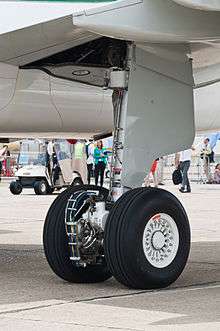EGTS International

Developed by a joint venture of Honeywell and Safran, EGTS is an electric taxiing system that is used prior to take off and can help airlines reduce cost by eliminating the need to use jet engines which are not efficient on the ground. It can also reduce foreign object damage and is environmental friendly as it reduce carbon and other emissions created during the taxiing phase. The main landing gear is equipped with electric motor powered by an Auxiliary Power Unit which allows the aircraft to pushback from the gate and taxi without a tug or its jet engines.[1] The system weight 300 kg and is permanently installed on the aircraft.[2] The system can accelerate the aircraft to 20 knots.[3]
The system was first demonstrated in 2013 during the Paris Air Show. A memorandum of understanding with Air France was announced to continue development efforts.[2]
In March 2014, Indian low cost carrier, GoAir signed a memorandum of understanding with EGTS to test the system and supply operational data to have an accurate projection of fuel saving to potential customers.[4]
Marketplace
Competitor Taxibot is currently the only certified & operational alternative taxiing system currently in the market, it is a semi robotic tractor which meets the aircraft for taxi-in and taxi-out, once connected it is controlled by the pilot. Competing products in development by WheelTug are different as they are installed on the nose gear.[5]
References
- ↑ "EGTS brochure".
- 1 2 "Honeywell, Safran Demo Electric Taxiing System For Airlines". 18 June 2013.
- ↑ "WheelTug, Safran-Honeywell and IAI Offer Three Rival Solutions for Airline Engine-off Taxiing". 11 February 2014.
- ↑ http://www.zacks.com/stock/news/126594/honeywell-amp-safran-sign-mou-for-egts
- ↑ "WheelTug, Safran-Honeywell and IAI Offer Three Rival Solutions for Airline Engine-off Taxiing". 11 February 2014.